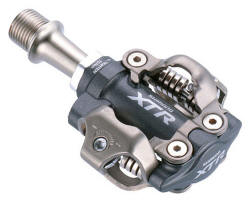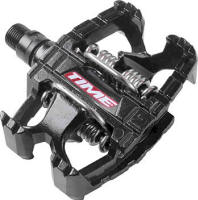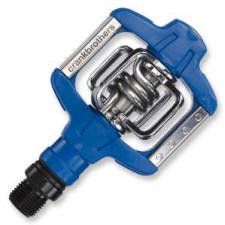Beginner's Guide to Clipless Pedals
original article by Matt Brady on 1 October, 2008
From my bike shop days, one of the most confusing things for new riders is the clipless pedal. There are a lot of myths and questions surrounding them, I hope I can shed some light on the differences and what they can do for you.
 Clipless
pedals allow a rider to clip into the pedal. Weird I know, but the term
actually evolved from the old cage/clip pedals. When the next generation
came out they were called clipless pedals. Clipless pedals require a special
shoe and pedal combination. A cleat that matches the pedal is attached to
the bottom of the shoe so you can attach yourself to the pedal. The shoes
not only provide a mounting point for the cleat, but feature stiff soles
to provide better power transfer. There are different kinds of shoes as
well; road and mountain, plus a few variations in between. Consult your
local bike shop for details.
Clipless
pedals allow a rider to clip into the pedal. Weird I know, but the term
actually evolved from the old cage/clip pedals. When the next generation
came out they were called clipless pedals. Clipless pedals require a special
shoe and pedal combination. A cleat that matches the pedal is attached to
the bottom of the shoe so you can attach yourself to the pedal. The shoes
not only provide a mounting point for the cleat, but feature stiff soles
to provide better power transfer. There are different kinds of shoes as
well; road and mountain, plus a few variations in between. Consult your
local bike shop for details.
The reason why clipless pedals are so popular is power. In a normal pedal
stroke all of your power is derived from the down stroke, when you push
down on the pedal. By clipping in, your foot is attached, so as you move
your foot down then back up and around, you pull the pedal with your leg.
This allows you to utilize some of the power you are already expending to
move your leg, as well as transfer more energy to your bike in every stroke.
As far as power goes, clipless pedals are the best for energy transfer,
even superior to cage pedals.
To use clipless pedals angle your foot forward, push the front of the cleat into the pedal, then push down to lock in the back of the cleat. To get out simply twist your heel to the outside, but be mindful not to pull up. This makes clipless pedals much easier and safer to get out of than the old cage pedals: Even when you fall, most of the time your feet will naturally clip out. You will probably fall the first few times, so when starting out it is a good idea to practice in a grassy field until you get used to the action.
When you are looking for clipless pedals you have a couple of options. The three major types for mountain biking are SPD, Crank Brothers and Time pedals. I haven’t had much experience with Time pedals, but they are usually preferred by downhillers and aggressive riders. Crank Brother are the most lax as they offer four sided entry, lots of float, and easy clipping out. As a side note float is the amount of movement you have back and forth before your foot clips out. These are great pedals to start on. SPD pedals offer two sided entry, have less float and hold you in better. They are a common choice for racers and anyone looking for a tighter feel. If you are a roadie turned mountain biker you’ll likely prefer SPDs. SPDs also come in hybrid varieties. These pedals have a standard platform on one side and an SPD mount on the other.
 There
are a lot of other factors to consider before you choose the perfect pedal.
Some designs have larger platforms to protect the pedal and spread your
weight over a larger area. Weight is also a consideration as is design.
For example Crank Brothers pedals are known for their extremely simple design
that utilizes open rails to shed mud and some alternate designs, like the
Candy C pedals, keep the pedal protected from impacts on the trail. For
more help your best resource is your local bike shop.
There
are a lot of other factors to consider before you choose the perfect pedal.
Some designs have larger platforms to protect the pedal and spread your
weight over a larger area. Weight is also a consideration as is design.
For example Crank Brothers pedals are known for their extremely simple design
that utilizes open rails to shed mud and some alternate designs, like the
Candy C pedals, keep the pedal protected from impacts on the trail. For
more help your best resource is your local bike shop.
If you have been considering cage pedals or have strayed away from clipless for one reason or another, I can say that they are much easier to use than many people often think; not to mention the extra power benefit is huge! They are not just for racers. The extra power can turn a discouraging trail into a worthy challenge.
Happy trails!
- copied from MTO Bikes' website - used with permission